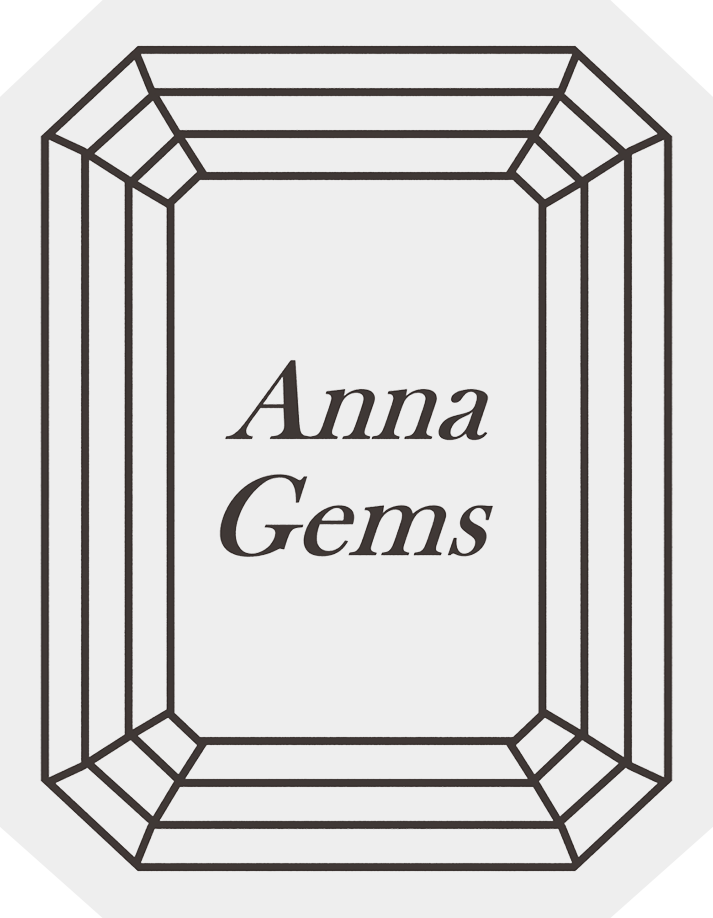EMERALD
Emeralds are the most highly valued gemstone (apart from diamonds) and are the rarest gemstone available.
They are considered the gem of royalty and romance. Emeralds are known for their deep green color and natural inclusions that make each one distinct. Emeralds are May’s birthstone and gifted traditionally on the 55th milestone anniversary. The scientific name for Emerald is natural beryl. The green coloring is attributed to trace elements of chromium and vanadium. Unlike many other precious gemstones, emeralds are much softer.
They rank 7.5 on the Mohs scale (diamonds are 10). Setting emeralds in jewelry requires a very high skill as they can break or chip under high pressure or exposure to high heat.
Emeralds naturally attain varying degrees of color depth and purity and all emeralds have many inclusions that occur during the natural growth process. Emeralds are evaluated by their color more than their clarity. The purer and more vivid deep green the color, the higher the value.

Emerald Shape
Emeralds are cut in many popular shapes, with the round cut emerald and octagon “emerald” cut shape being most popular. Round emeralds can also improve the refractive quality of the emerald, giving it more sparkle.
However, more than other gemstones, color reigns supreme. Following closely behind round, cushion cut emeralds have become quite popular as well, but are typically available in 6mm+ (~1.00ct+). Other shapes include Oval, Princess, Pear, and Marquise. Most fancy shapes are significantly less expensive than round and emerald cut emeralds. Oval and pear cut emeralds are typically available in all sizes. Princess, also called square, emeralds are typically available in sizes smaller than 5mm.
This is due to rough wastage and demand and supply for those shapes. Emeralds have become a very popular alternative to diamonds for engagement rings. In many instances, they can be as expensive as diamonds, so it’s really a matter of preference.
Emerald Size
Emeralds are cut and measured in millimeters from length to width, not by carat. Carat weight is more of an approximation for emerald size. In order to showcase the emerald’s color, it may be cut deeper or shallower, affecting the carat weight drastically, even though the length and width of the shape are the same. As emerald size increases, the price increases exponentially. The round and octagon shaped emerald will look largest. Cushions and princess cuts will look smallest. Squarer shapes tend to distribute more size and weight in the depth of the Gemstone. In diamonds, a manufacturer may reduce the size to remove inclusions; this is rarely the case with emeralds because inclusions are present throughout natural emerald.


Emerald Color
The single greatest factor for an emerald’s value is it’s color. The emerald is examined and graded based on its hue, tone and saturation of color. These three elements will ultimately determine whether the emerald is AAA quality (highest) or C quality (lowest). While evaluating color is subjective and no standardization exists across the industry, color is graded AAA, AA, A, B, and C. Emeralds are green, but many may have undertones of yellow, blue and brown. The purer the green, the higher or better the color. Emerald color is evaluated by viewing the Gemstone face up, without magnification. It can be rocked and tilted to see the color from many angles. Ideally the hue will be green, without additional color undertones. The tone will be vivid and deep, not too dark or light. The saturation will be even and fluid throughout.
We generally recommend Emeralds with a deep green color or those with a light undertone of yellow. Emeralds with brown or blue undertones will not look as visually appealing.
Emerald Clarity
Emeralds are some of the most heavily included gemstones available. All emeralds will have tiny imperfections, known as inclusions, that may be visible without magnification. Emerald inclusions include clouds, needles, crystals, feathers, pinpoints and cavities. The inclusions occur naturally during the emerald growth process. There is no standardized grading scale for clarity in emeralds. They simply blend with color in the AAA rating scale.
Because inclusions are found in all emeralds, it is recommended not to worry too much about their visibility in higher qualities. The color is the dominant factor in determining the emerald quality. However, very large, heavily included emeralds will have color reduction as the color will be washed out by the inclusions. If this is the case, the quality grade of the emerald will be reduced.
Emerald clarity, like its color, is evaluated face up without magnification. The key is to see the clarity as a whole rather than concentrating on an individual inclusion. The most common inclusions are fissures or tiny fractures that look like wavy or random whitish lines inside the emerald.

Emerald Sourcing
Emerald mining is an interesting process. Emeralds typically attach to other rock formations and are not found as standalone rough gemstone. Emerald mining is often done by hand because technology and machinery can increase heavy pressure on the rock formations and break apart heavily included emeralds. Typically, emeralds are mined in pits and rock is blasted into larger pieces. Those pieces may or may not have emerald (natural beryl) and that is hauled away for removal and ultimately for manufacturing.

With Clarity Emeralds are typically mined in Colombia, Zambia and Brazil. Each region is known to produce high quality emeralds with less inclusions and a more vivid green color (fewer undertones). At times, emeralds mine origin can even be identified just by color. We work directly with manufacturers and miners in these local communities that support safe environmental practices, community building human rights protections. Emerald mining is a major support structure for towns around the world. Investment in mining supports school, public facilities and hospitals. Our responsibility and commitment is ultimately to the locations that produce high quality gemstones. We work with suppliers to ensure fair labor practices and laws are followed. We’ve even directly visited mines to ensure direct sourcing and supplier reliability.
Emeralds are a common alternative to diamonds for engagement rings. Apart from being unique, they are considered a sophisticated, rich and royal gemstone. Because Emeralds are more rare than diamonds, they’re not a consistent source for fueling conflict. This is great because it ensures your gemstone is conflict free and your love is not tainted.
Emerald Certification
Because they’re a precious gemstone, it can be important to identify the quality of emeralds. Certification of emeralds will confirm whether your emerald is natural or nonnatural. Typically, you do not need to certify emeralds under 6.5mm size, subject to a trusted jeweler. Because there is no quality grading scale that exists for emeralds, the value of certification is reduced. Certification can confirm the emerald’s origin and nature, which may be important to someone.
Reputable grading laboratories include GIA, AGS and AGL. With Clarity gemologists are trained by GIA and verify the emerald’s nature. We independently certify and check every gemstone in our jewelry. We also only source the top 1% of quality. You’ll immediately notice that our gemstones are a deeper green and less included.
Rather than going the route of certification, which can cost hundred per carat (certification costs are based on the size of the emerald), certified appraisals can accomplish similar goals. Advances in tools and technologies make it possible for skilled gemologists to identify the nature of a gemstone.
We recommend natural emeralds over synthetic emeralds. Fake or nonnatural emeralds will never look the right tone of green and are often treated too much to bring out color. Additionally the lack of inclusions actually can make an emerald look less attractive. The natural nature of inclusion provide an identification and exciting appeal associated with emeralds. Additionally, emeralds are a symbol of love and commitment. A synthetic gemstone is seldom recommended as a means to strengthen a natural relationship.
Emerald Treatments
Like other gemstones, emeralds very commonly undergo treatments to improve color and sparkle/luster. Because emeralds tend to have more inclusions than other gemstones, treatments are often required to import their purity. These treatments are intended to repair and protect fractures and fissures that occur naturally during the growth process. They can also improve the emerald’s color to a more vibrant pure green. Over 99% of emeralds undergo treatments. Untreated emeralds are extremely rare and can be over 10-20 times more expensive than treated emeralds. The most common emerald treatments include oiling, dyeing, irradiating and lasering. With Clarity emeralds only undergo oil treatment, which is a standard industry practice. We do not deploy dyeing and color enhancement treatments that may be temporary.
During the oil treatment, emeralds are soaked in hot cedar oil. Cedar oil has the same rating on the refractive index, making it a great selection for emeralds. The hot oil is intended to soak into cracks, fractures and fissures. Once inside, the emerald is cooled and the cedar oil solidifies. The result is a significant reduction in clarity inclusions and overall improvement in the health and structure of the emerald. Additionally, it will have more luster/brilliance and the color will be improved by reduce the clarity inclusions.
With Clarity discloses all treatments to colored gemstones as we believe in the additional transparency. We test our gemstones to confirm treatments and we do not utilize any treatments that compromise the value and integrity of the gemstone.

